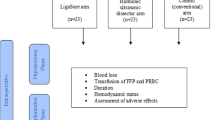Abstract
Objective
To clarify the benefit of energy devices such as ultrasonically activated device and bipolar vessel sealing device in liver surgeries.
Background
Several studies have suggested the benefit of energy devices in liver transection, while a randomized trial has found no association between their use and surgical outcomes.
Patients and methods
Patients scheduled to undergo open liver resection were eligible for this multicenter non-blinded randomized study. They were randomized to receive an energy device (experimental group) or not (control group) during liver transection. The primary endpoint was the proportion of patients with intraoperative blood loss >1,000 mL. The primary aim was to show non-inferiority of hepatectomy with energy device to that without energy device.
Results
A total of 212 patients were randomized and 211 (105 and 106 in the respective groups) were analyzed. Intraoperative blood loss >1,000 mL occurred in 15.0 % patients with energy device and 20.2 % patients without energy device. The experimental minus control group difference was −5.2 % (95 % confidence interval −13.8 to 3.3 %; non-inferiority test, p = 0.0248). Hepatectomy with energy device resulted in a shorter median liver transection time (63 vs. 84 min; p < 0.001) and a lower rate of postoperative bile leakage (4 vs. 16 %; p = 0.002).
Conclusions
The hypothesis that hepatectomy with energy device is not inferior to that without energy device in terms of blood loss has been demonstrated. The use of energy devices during liver surgery is clinically meaningful as it shortens the liver transection time and reduces the incidence of postoperative bile leakage.


Similar content being viewed by others
References
Kanehira E, Omura K, Kinoshita T et al (1999) How secure are the arteries occluded by a newly developed ultrasonically activated device? Surg Endosc 13:340–342
Sugo H, Mikami Y, Matsumoto F et al (2000) Hepatic resection using the harmonic scalpel. Surg Today 30:959–962
Romano F, Franciosi C, Caprotti R et al (2005) Hepatic surgery using the Ligasure vessel sealing system. World J Surg 29:110–112. doi:10.1007/s00268-004-7541-y
Rahbari NN, Koch M, Schmidt T et al (2009) Meta-analysis of the clamp-crushing technique for transection of the parenchyma in elective hepatic resection: back to where we started? Ann Surg Oncol 16:630–639
Saiura A, Yamamoto J, Koga R et al (2006) Usefulness of LigaSure for liver resection: analysis by randomized clinical trial. Am J Surg 192:41–45
Sakamoto Y, Yamamoto J, Kokudo N et al (2004) Bloodless liver resection using the monopolar floating ball plus ligasure diathermy: preliminary results of 16 liver resections. World J Surg 28:166–172. doi:10.1007/s00268-003-7167-5
Nanashima A, Tobinaga S, Abo T et al (2010) Usefulness of the combination procedure of crash clamping and vessel sealing for hepatic resection. J Surg Oncol 102:179–183
Gotohda N, Konishi M, Takahashi S et al (2012) Surgical outcome of liver transection by the crush-clamping technique combined with Harmonic FOCUS. World J Surg 36:2156–2160. doi:10.1007/s00268-012-1624-y
Ikeda M, Hasegawa K, Sano K et al (2009) The vessel sealing system (LigaSure) in hepatic resection: a randomized controlled trial. Ann Surg 250:199–203
Dindo D, Demartines N, Clavien PA (2004) Classification of surgical complications: a new proposal with evaluation in a cohort of 6336 patients and results of a survey. Ann Surg 240:205–213
Ijichi M, Takayama T, Toyoda H et al (2000) Randomized trial of the usefulness of a bile leakage test during hepatic resection. Arch Surg 135:1395–1400
Mangram AJ, Horan TC, Pearson ML et al (1999) Guideline for prevention of surgical site infection, 1999, Hospital Infection Control Practices Advisory Committee. Infect Contro Hosp Epidemiol 20:250–278 Quiz; 279-280
Freidlin B, Korn EL, George SL et al (2007) Randomized clinical trial design for assessing noninferiority when superiority is expected. J Clin Oncol 25:5019–5023
Romano F, Garancini M, Caprotti R et al (2007) Hepatic resection using a bipolar vessel sealing device: technical and histological analysis. HPB (Oxford) 9:339–344
Evrard S, Becouarn Y, Brunet R et al (2007) Could bipolar vessel sealers prevent bile leaks after hepatectomy? Langenbecks Arch Surg 392:41–44
Arru M, Pulitano C, Aldrighetti L et al (2007) A prospective evaluation of ultrasonic dissector plus harmonic scalpel in liver resection. Am Surg 73:256–260
Jagannath P, Chhabra DG, Sutariya KR et al (2010) Fusion technique for liver transection with Kelly-clysis and harmonic technology. World J Surg 34:101–105. doi:10.1007/s00268-009-0282-1
Riediger C, Mueller MW, Geismann F et al (2013) Comparative analysis of different transection techniques in minor and major hepatic resections: a prospective cohort study. Int J Surg 11:826–833
O’Rourke N, Shaw I, Nathanson L et al (2004) Laparoscopic resection of hepatic colorectal metastases. HPB (Oxford) 6:230–235
Vibert E, Kouider A, Gayet B (2004) Laparoscopic anatomic liver resection. HPB (Oxford) 6:222–229
Koffron AJ, Stein JA (2008) Laparoscopic liver surgery, parenchymal transection using saline-enhanced electrosurgery. HPB (Oxford) 10:225–228
Acknowledgments
The authors express deep gratitude to Dr. Tomoo Kosuge for his help and encouragement. We thank Drs. Junichi Arita, Takashi Mizuno, and Shutaro Hori for their various supports. Finally, we thank all patients and their families who participated in this study.
Disclosure
This study was supported by a grant-in-aid for Cancer Research from the Ministry of Health, Welfare, and Labor of Japan (21-7-5).
Conflicts of interest
The authors declare that they have no conflicts of interest to disclose.
Author information
Authors and Affiliations
Corresponding author
Additional information
UMIN Clinical Trials Registry (http://www.umin.ac.jp/ctr/index.htm): UMIN000006044.
Rights and permissions
About this article
Cite this article
Gotohda, N., Yamanaka, T., Saiura, A. et al. Impact of Energy Devices During Liver Parenchymal Transection: A Multicenter Randomized Controlled Trial. World J Surg 39, 1543–1549 (2015). https://doi.org/10.1007/s00268-015-2967-y
Published:
Issue Date:
DOI: https://doi.org/10.1007/s00268-015-2967-y




